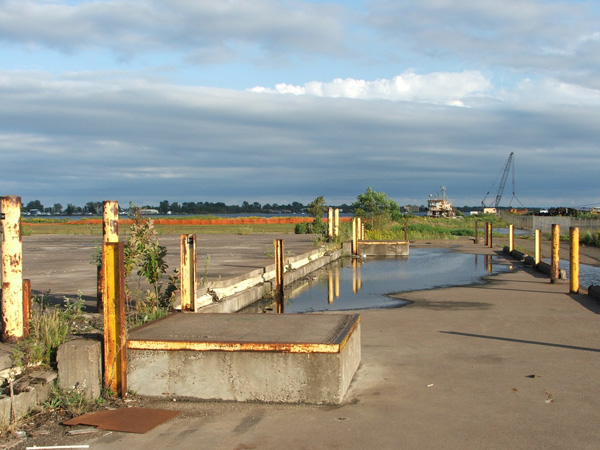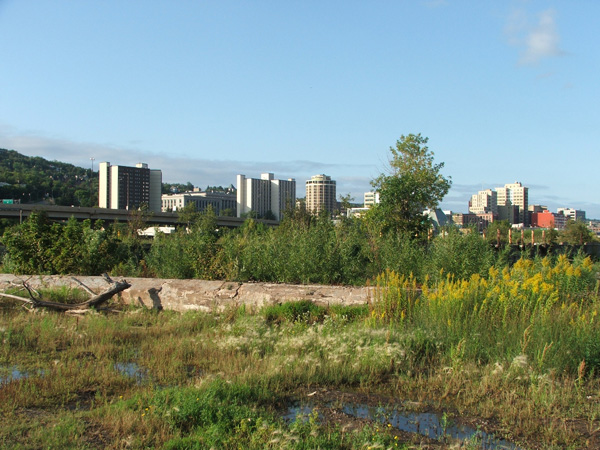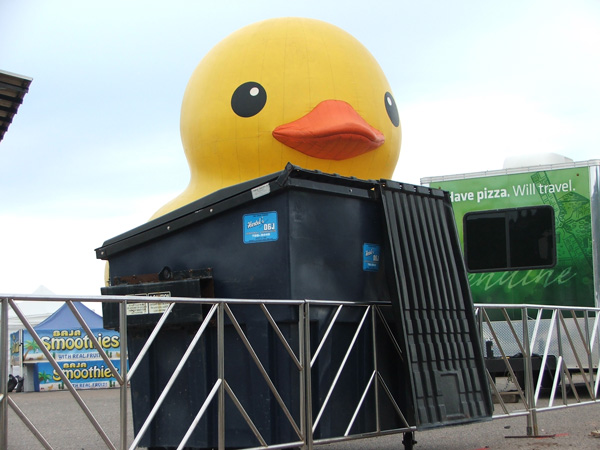Sports tourism
On August 18, 2016, Visit Duluth, the city’s tourism bureau, hosted a meeting at the Canal Park Lodge to hear from Jon Schmieder and Gary Alexander, consultants who had produced a report on the future of sports tourism in Duluth. Schmieder and Alexander are principals of the Huddle Up Group, a Phoenix-based consultancy. They cited a figure that sports tourism currently accounts for 31 percent of hotel stays in Duluth. Visit Duluth hired them to develop recommendations to help Duluth capture a larger share of the $9 billion industry.
The idea most strongly advocated by the consultants, both in their written report and their presentation, was the creation of a regional sports commission. Duluth already has a number of established sports events and venues—Grandma’s Marathon, the Northern Lights Basketball League, UMD and public school facilities, the Curling Club, the Heritage Center and more—but what the consultants noticed was a lack of communication among the various groups. Each group does its own thing without coordinating with their counterparts. They also noticed that community leaders did not seem to be aware of sports tourism’s impact. A new sports commission, they felt, would address both problems.
As envisioned by the consultants, Visit Duluth would hire “a new senior executive” to head the sports commission, which would include representatives from sports programs in Duluth, Superior, Proctor, Hermantown and the region. This would allow greater coordination and collaboration among the parties, as well as raise the profile of sports tourism and provide a formal fundraising platform. A shared calendar of all events going on in the area would help everyone make more strategic decisions that would benefit the region as a whole.
The consultants also suggested that the sports commission, though it would be an arm of Visit Duluth, should have “its own branding, web site, and staff,” as well as its own board of directors. They recommended that the commission organize a “monthly road show” to educate various community groups about the value of sports tourism. They also recommended scheduling smaller presentations for business leaders to draw them into the loop.
Schmieder warned that because Visit Duluth has a relatively small sports tourism budget, he did not believe they should spend a lot of time bidding against other communities to host larger events. “We have a BB gun and our opponents have howitzers. We have a limited budget [and] limited staff
so we [would be] playing a game at which I don’t think we can win.”
Rather, he suggested, the sports commission could offer financial incentives to promoters who wanted to create new events, especially at times of the year when tourism is slower. “Over time, by doing that
we’ll build so much inventory that we won’t have to go to five conferences a year and compete with the Richmonds and the Eau Claires and the Twin Cities. We won’t have to compete with anybody, because we will have created all this other inventory.”
“The end goal,” states the Huddle Up report, “is for the new sports commission to be viewed as the ‘go to’ organization when its partners need help to host an event.”
With regard to one idea, the consultants’ comments at the presentation seemed to differ from their written report. In the report, they mentioned several times that building a new facility for indoor sports would be a desirable thing to do. In fact, it was one of their top five priorities.
While the Consultant Team believes there is opportunity to increase the region’s sports tourism under current market conditions, in the future the new sports commission could lead the way in the creation of new venues in the area. Specifically, once the sports commission is up and running, the Consultant recommends the sports commission leadership engage the decision makers that control various funding sources (examples: LISC, Duluth half and half tax) to help fund a new indoor sports facility in the West Duluth area.
Later, they wrote, “There is a strong national trend where destinations are putting [tourism] tax funds into the construction and/or operation of new sports facilities. This is something [that Visit Duluth] should also consider in the future.”
At the presentation, however, they downplayed the idea of a new facility. Schmieder said the type of facility necessary to raise Duluth above the crowd would cost $40- to $50 million, and in their discussions with the community, “There was no funding mechanism in place. Nobody had really an interest to hold their hand up and say, ‘I will pay for that’ or ‘I will raise the money for that.’ So we went a different path and we ended up in a much different place, [focusing on] human capital instead of physical capital.”
Nevertheless, the recommendation remains in the report, and Duluth is a city that loves to build things, especially for the tourism industry. I can’t think of any big tourism project where somebody raised their hand and said they would pay for it, except for Bayfront Festival Park, which was paid for by Lois Paulucci. The Great Lakes Aquarium, the DECC expansion, AMSOIL Arena, improvements at Spirit Mountain—all came about because the tourism industry convinced the city to pay for them. In the future, I would not be surprised to see the tourism industry pushing for a new sports facility. It’s been a few years since the city established new tourism taxes to build something, so people are bound to be getting restless.

Lot D
Ever since the Pier B Resort began taking shape on the waterfront, transforming an old cement works into something shiny and new, city business developers have been looking at Lot D, the 13-acre expanse of weedy industrial wasteland immediately to the west. Lot D is owned by the Duluth Economic Development Authority (DEDA).
To prepare the site for development, DEDA applied for a clean-up grant from the federal Environmental Protection Agency to mitigate contamination on the site. They received a $200,000 grant, to which they added $40,000 of DEDA money. According to city business resources manager Heidi Timm-Bijold, so far DEDA has spent about $30,000 for a “geophysical survey” to determine what is underneath the surface of the site and a “foundation structural engineering study” to determine the condition of an existing one-acre foundation on the site. Potential developers will be able to use this information to decide if they want to get rid of the foundation or build on top of it.
Contracts were also awarded to two firms to begin remediation of the site, but that part of the project has run into a snag. By law, federally-funded projects are required to consult with the State Historic Preservation Office (SHPO, pronounced “Shippo”) before commencing. This requirement has stopped work on Lot D for the moment. According to Timm-Bijold, SHPO is asking for “a historic assessment of the Bayfront district and possibly an archeological survey” to determine anything of historic value on Lot D. Timm-Bijold remains hopeful that the clean-up work will be finished by December 15, but she cautioned the DEDA board that the end date might have to be extended into the spring, depending on what SHPO asks for.
As for which specific developers are interested in Lot D and what types of projects they want to build, the city is not saying. DEDA executive director Heather Rand told the DEDA board that the business development office was continuing to talk with two developers who had expressed interest.
“The concepts certainly look very intriguing, and not necessarily anything that we have currently in Duluth,” Rand said mysteriously. “Of course we don’t want to re-create something that already exists within, say, Canal Park or downtown. We’re looking for something unique that’s going to add additional vitality to that Bayfront area.”
Rand hopes to have something definite to tell the DEDA board by their September 28 meeting. When I spoke with her just prior to this column going to print, she said, “We intend to make a recommendation for a developer that we would enter into an option agreement with, and then we would [give them] 6 months to 18 months [to purchase the property, while they] continue to do due diligence and continue to work out site plans that are amenable to DEDA.”

Pier B
Speaking of Pier B, that project, too, has run into some delays. The hotel and restaurant are open and the sliding bridge across the mouth of Slip 2 is in place, but work on the Bayfront Park side of the slip has proceeded more slowly than expected.
As part of Pier B’s agreement with DEDA, Pier B must stabilize the wall of the slip with riprap and sheet piling and build a paved path along it, and DEDA will reimburse them up to $1 million. The original agreement called for the work to be done by the end of 2015. Permitting issues and weather, as well as the need to halt work during Bayfront Park events, have led to a number of delays. The deadline has been extended three times, most recently at DEDA’s August 24 meeting, when the board extended it to September 30.
“This is not unusual to see some of our agreements [get] extended, but we want to be sure this is the last time,” DEDA board chair Nancy Norr said pointedly.
“I’m not going to fall on my sword over this date,” said Heidi Timm-Bijold, “but I will tell you that I did go to the project manager
and said, ‘Will it really, really, really be done [by September 30]? Because I do not want to do this again.’ And they are very confident, and assured me that it will be completed by then, because now things are well within their control. We have the permitting set aside
and the progress is highly visible.”

Rubber ducky
Speaking of highly visible, this year’s Tall Ships Festival also featured a giant rubber ducky. A lot of people took to social media and the newspaper opinion page to complain about the duck, saying it detracted from the majesty of the ships. I can see the point, but everything about the festival detracts from the majesty of the ships—the food trucks selling overpriced hamburgers, the cheap trinkets for sale in vendors’ tents, the bands playing music at Bayfront. Seventeenth-century sailors did not listen to rock and roll. When you look at the whole picture, the ducky seems to fit right in.
One evening, after the tents and food trucks had closed, my family and I took a stroll along the waterfront to look at the ships. My kids ignored them entirely and ran to see the duck. Kids don’t care about majesty.
The Chisholm version
In my last column, I described the scene at the August 11 Chisholm city council meeting, where Mayor Mike Jugovich and city councilors badgered a citizen who had posted something mildly critical on Facebook about an ill-advised movie studio deal the city entered into. Curious as to what the official version of this public shaming session might be, I looked up the minutes of the meeting. Here is what they said:
“Councilor T. Scaia
invited Brandan Fiedler (candidate running for City Council) to the podium to discuss any concerns he may have with the Council regarding Ironbound Studios.”
When historians of the future look back, that is all the information they will find.